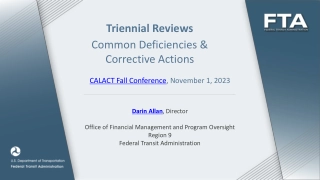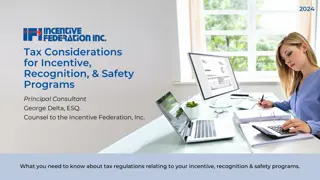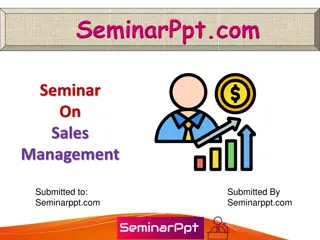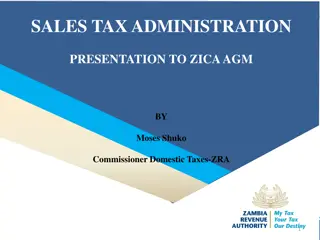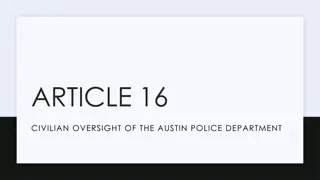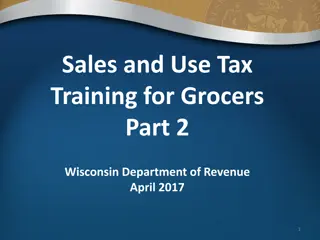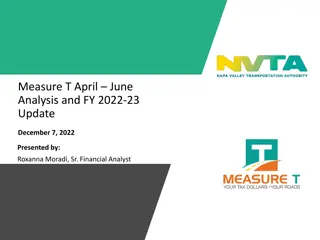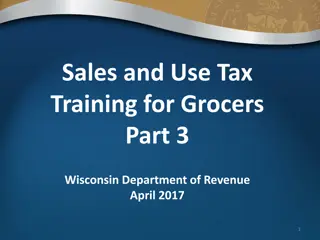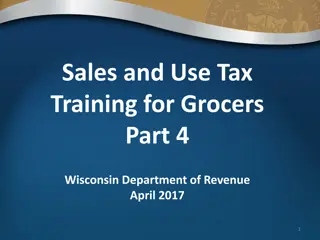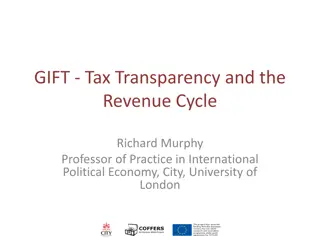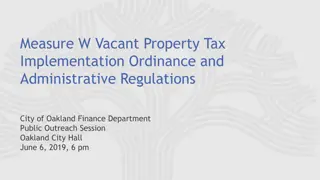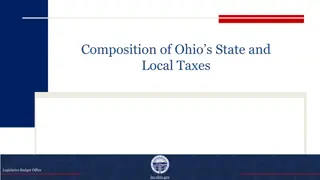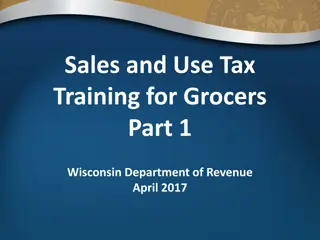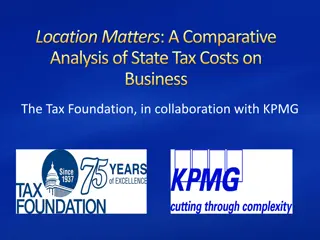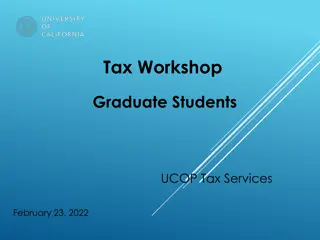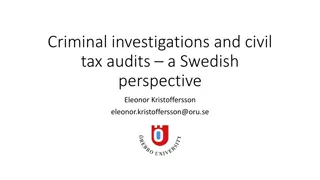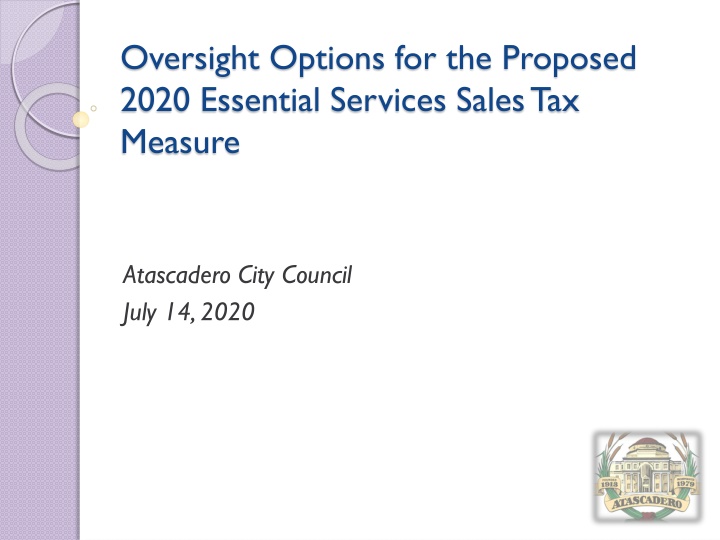
Essential Services Sales Tax Oversight Options for Atascadero City Council
Explore oversight options for the proposed 2020 Essential Services Sales Tax Measure discussed at the Atascadero City Council meeting. Recommendations focus on engaging the public, developing accountability, and minimizing additional costs.
Download Presentation

Please find below an Image/Link to download the presentation.
The content on the website is provided AS IS for your information and personal use only. It may not be sold, licensed, or shared on other websites without obtaining consent from the author. If you encounter any issues during the download, it is possible that the publisher has removed the file from their server.
You are allowed to download the files provided on this website for personal or commercial use, subject to the condition that they are used lawfully. All files are the property of their respective owners.
The content on the website is provided AS IS for your information and personal use only. It may not be sold, licensed, or shared on other websites without obtaining consent from the author.
E N D
Presentation Transcript
Oversight Options for the Proposed 2020 Essential Services Sales Tax Measure Atascadero City Council July 14, 2020
Summary Council requested staff bring recommendations on processes to formally engage the public and to develop a plan of accountability Options range in level of detail, outreach, cost, and commitment of staff resources
Key Priorities Formally engage the public Develop a plan of accountability Minimize additional administrative costs as good stewards of public funds
Phased Approach Phase 1: Gather public opinion and input on community goals Phase 2: Provide accountability and transparency
Phase I: Gather Input & Public Process Gather Information & Public Input Council Strategic Planning Adjusted Budget Approved by Council Public engagement highly encouraged. Typically minimum of 8 public meetings. Establish Priorities Staff Strategic Planning Finance Committee Detailed Meetings Refine Revenue Projections Develop Action Plans Council Adopts Action Plan Supplemental Requests
Phase I: Gather Input & Public Process Public input always encouraged Council always has the ability to change where funds will be spent The first budget year after implementation will be the most critical in determining priority focus of funds Commitments such as debt service or public safety staffing costs would be difficult to de-obligate after being funded
Phase I: Options 1. Citizen Committee $$$$ 2. New Public Process $$ 3. Expand Current Process $$
Phase I: Option 1 1. Citizen Committee i. Appointed committee to make recommendations for how the funds are spent ii. Puts an extra layer between the voters and their elected decision makers iii. Requires significant staff time iv. Would require a very high level of additional administrative costs $$$$
Phase I: Option 2 2. New Public Process i. Series of new study sessions and surveys to be held to receive input on the public s priorities and to build a common understanding of the current budget, needs and implications of decisions ii. Input would be brought to Council to help provide direction on priorities iii. Would be followed by standard budget process iv. Would require a moderate level of additional administrative costs $$
Phase I: Option 3 3. Expand Current Process i. Expand current budget process to seek out and receive public input on the expenditure of these funds ii. Build common understanding of the City s finances and receive input on community priorities iii. Information would be brought to Council Strategic Planning sessions for prioritization iv. Would require a moderate to low level of additional administrative costs $-$$
Phase 2: Public Engagement and Accountability Demonstrate to the public that funds were spent for the priorities established in Phase 1 Citizen s Sales Tax Oversight Committee (CSTOC) fulfills this role for Measure F-14 Separating expenses for Essential Services will be much more challenging than Measure F-14
Phase 2: Public Engagement and Accountability Measure F-14 pays for a limited number of large projects with defined contracts and invoices Essential Services Measure, if passed by voters, will provide funding for fire, paramedics, police, emergency response, park maintenance, infrastructure, etc., maintaining existing service levels By the nature of the costs, more difficult to separate out
Phase 2: Public Engagement and Accountability
Phase 2: Public Engagement and Accountability Transparency and public trust are paramount 76% satisfied with the City s efforts to provide municipal services 60% responded positively regarding the City s fiscal management
Phase 2: Public Engagement and Accountability Cost allocation is subjective in some cases There might be two right answers Staff is reluctant to overpromise what can be objectively delivered Challenges to staff s decisions might erode public trust and confidence in the City s sound fiscal management Staff/resource intensive
Phase 2: Options 1. Community Appointed Committee and Annual Report 2. Council Appointed Committee and Annual Report 3. Annual Report Only- Allocated Expenditures 4. Finance Committee Meetings- Allocated Expenditures 5. Annual Report Only- Budgeted Expenditures 6. Public Input on Big Picture Priorities $$$$ $$$ $$$ $$$ $ $
Phase 2: Option 1 1. Community Appointed Committee and Annual Report i. Set up similar to CSTOC ii. CSTOC could perform the duties iii. Annual report could be reviewed by committee and mailed to residents iv. Difficult to fill the committee due to legal reporting and requirements v. High cost to prepare and mail the report, manage the committee, prepare agendas, staff reports, etc. vi. High cost to separately allocate costs $$$$
Phase 2: Option 2 2. Council appointed Committee and Annual Report i. Council appointed committee, similar to Planning Commission ii. May not appear as independent as a community appointed committee iii. Annual report could be reviewed by committee and mailed to residents iv. High cost to prepare and mail the report, manage the committee, prepare agendas, staff reports, etc. v. High cost to separately allocate costs $$$
Phase 2: Option 3 3. Annual Report Only- Allocated Expenditures i. No separate committee ii. Annual report mailed to residents iii. High cost to prepare and mail the report iv. High cost to separately allocate costs $$$
Phase 2: Option 4 4. Finance Committee Meetings- Allocated Expenditures i. No separate committee ii. No separate annual report iii. Expand public Finance Committee Meetings to review the expenditures of the new Measure iv. High cost to separately allocate costs $$$
Phase 2: Option 5 5. Annual Report Only- Budgeted Expenditures i. Annual report based on Council approved budget ii. Focus on which budgeted amounts would come from Sales Tax Measure and which would come from existing City funds iii. Saves considerable amount of staff time in determining allocation methodology and tracking/splitting costs iv. Provides the public with a list of what was added to the budget because of the Sales Tax Measure $
Phase 2: Option 6 6. Public Input on Big Picture Priorities i. Emphasizes community s priorities ii. Changes focus from which dollar in the pool is being spent to what are we accomplishing with that dollar iii. Increased public participation in ongoing budget decisions will provide additional oversight and transparency for ALL funding sources iv. Emphasis on overall priorities to focus on where we are, how far we ve come, and what we have yet to accomplish $
Key Priorities Formally engage the public Develop a plan of accountability Minimize additional administrative costs as good stewards of public funds
Conclusion There are multiple options, all with different levels of reporting and costs Goal is to use the funds for highest and best use for the community as a whole City works hard to earn the public s trust regarding management of ALL City funds City officials are responsive to residents needs and priorities and have invested wisely
Conclusion (cont.) These funds, as well as ALL of City s funds, are included in annual independent financial audit As elected representatives of the community, Council has the ultimate privilege and responsibility to determine how to allocate City resources
Recommendation Council provide staff direction on the process to formally engage the public and to develop a plan of accountability.

